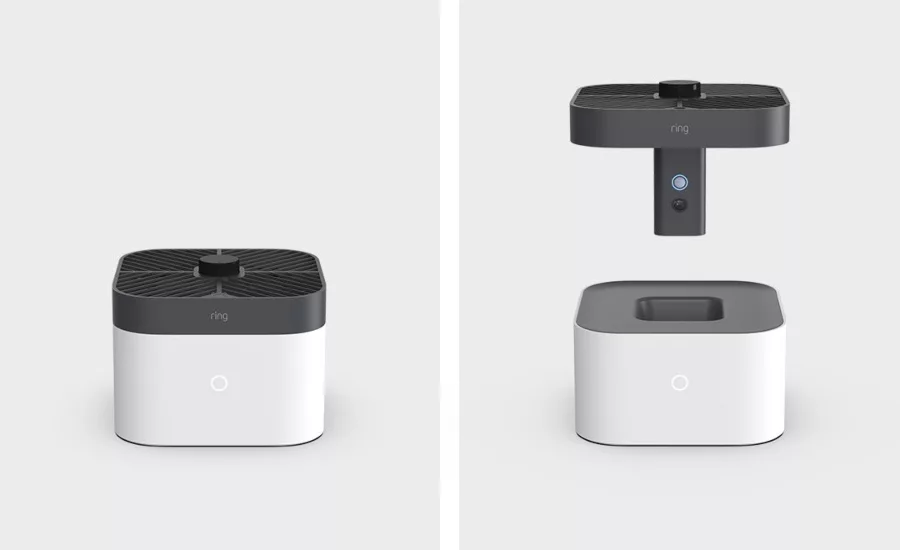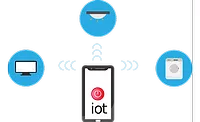Amazon unveils "flying camera" that launches if intrusions are detected

Amazon's Ring latest home security camera — the new Always Home Cam. Image courtesy of Amazon
Amazon's smart home security division Ring has unveiled a flying camera that launches if sensors detect a potential home break-in. It is designed to activate only when residents are out, works indoors, and is limited to one floor of a building.
According to an Amazon blog, this autonomous indoor security camera flies an user's chosen, personalized paths so that users can easily check in on their home for peace of mind — like whether someone left a window open or forgot to turn the stove off.
The Ring Always Home Cam also integrates with Ring Alarm — Ring's home security system. When Ring Alarm is triggered while in Away Mode, the Always Home Cam will automatically fly a set path to see what’s happening. Users will be able to stream video while the camera is in-flight via the Ring App, making sure that users are aware of what is happening at home.
Amazon says the autonomous indoor security camera was developed with "privacy and security" in mind. They note the device rests in the base and the camera is physically blocked when docked. The camera will only start recording when the device leaves the base and starts flying via one of the preset paths. Obstacle avoidance technology in the device allows it to avoid unexpected objects as it moves on the pre-set paths, and its small size, lightweight design and shrouded propellers enable it to move safely throughout the home, Amazon claims.
Cybersecurity professionals, however, raise questions and concerns over the device's privacy.
“Smart home devices, such as Ring, collect an inordinate amount of sensitive personal data in real time – this is typically transmitted to a cloud service for processing. A critical question is who has access to the data collected by the device, and whether it is processed and stored in a lawful manner that protects personal data from unauthorized use," says Emma Bickerstaffe, Senior Research Analyst at the Information Security Forum, a London-based authority on cyber, information security and risk management.
"A privacy concern raised by existing smart home devices is the ability to take the personal data captured by sensor technology and together with connections to devices, identify patterns in an individual’s daily routine and build a comprehensive, digital picture of their activities. The ability for Ring to conduct private videoing within an household exponentially accelerates the ability for organizations to track individuals’ daily life, habits and preferences, and use this information for commercial gain."
Rick Holland, Chief Information Security Officer, Vice President Strategy at Digital Shadows, a San Francisco-based provider of digital risk protection solutions, also notes that for privacy advocates, the concept of an untethered IoT device surveilling the house is disturbing. "Coupled with Ring's controversial privacy practices, the adoption of the drone could be low. However, those that have already embraced the concept of in-house security cameras are likely to be excited. The prospect of having a single drone monitor your house instead of multiple individual cameras could be alluring," Holland explains.
Joseph Carson, chief security scientist at Thycotic, a Washington D.C. based provider of privileged access management (PAM) solutions, claims that the responsibility of drones falls on both manufacturers and regulators within countries to ensure that they meet minimum safety specifications preventing them from being easily abused. "Moving forward, drones should require a basic safety requirement, registration or automatic prevention from flying in certain areas that require a code to unlock, which is of course pre-registered,” Carson adds.
"Close attention should be paid to the security controls adopted by Ring. Cybercriminals are already maximizing the opportunity to exploit vulnerabilities in smart home devices as a stepping stone to target the network on which these devices are installed. Now that much of the world is currently working from home, smart home devices play even more to the advantage of cyber attackers, presenting an attractive way for adversaries to access and compromise valuable business information,” Bickerstaffe says.
Holland adds, "For those that do opt for the security drone, the proper configuration will be critical to minimize security and privacy risks as much as possible. Consumers must enable multi-factor authentication and automatic software updates to ensure that any vulnerabilities are quickly resolved.”
Looking for a reprint of this article?
From high-res PDFs to custom plaques, order your copy today!





